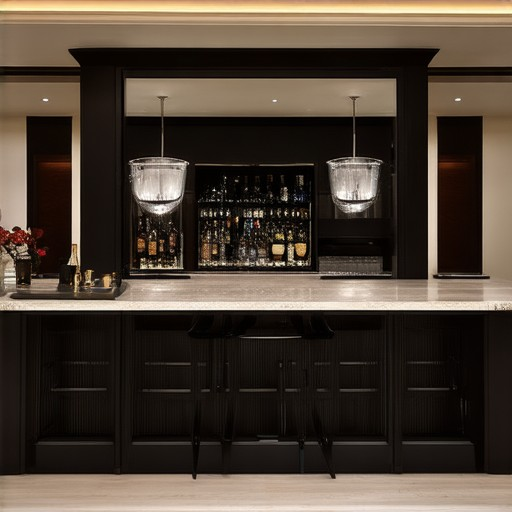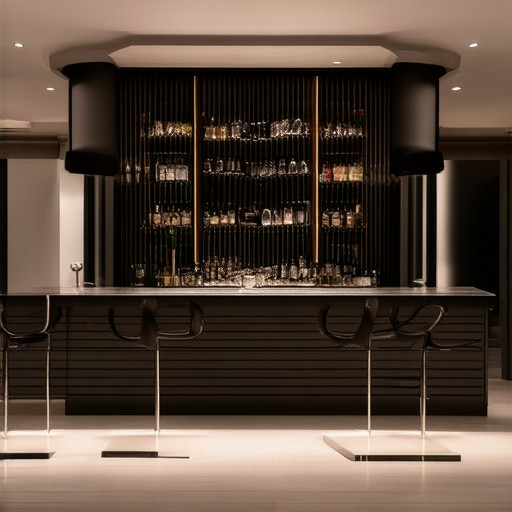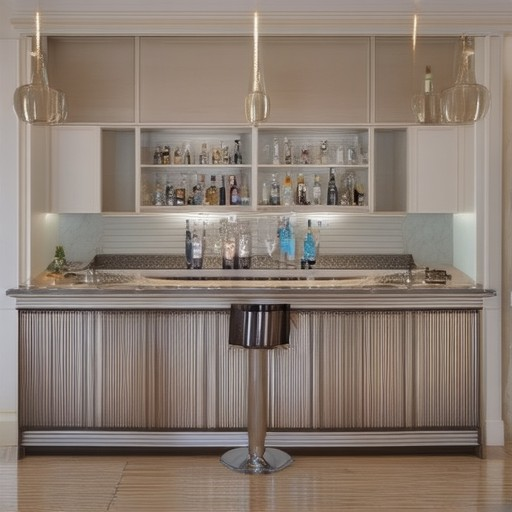Elevating your home bar design is a fantastic way to transform your space into a sophisticated hub, whether you’re hosting guests or enjoying a relaxing moment alone. With the right combination of size, color, and layout, your home bar can become the centerpiece of your living area. From selecting the perfect dimensions to choosing a color scheme that complements your decor, there are countless factors to consider when designing a functional and aesthetically pleasing home bar. This guide will walk you through essential tips to create a bar that not only looks stunning but also meets your practical needs. Whether you’re aiming for a sleek modern look or a cozy, rustic vibe, we’ve got expert advice to help you achieve the perfect setup. Discover how to maximize space, choose colors that harmonize with your surroundings, and design a layout that enhances both functionality and style. Let’s dive into the details and uncover the secrets to crafting a home bar that truly stands out.

How to Make Your Home Bar Look Great
Transforming your home bar into a stylish and functional space requires careful planning and attention to detail. Here’s how you can make your home bar look its best:
1. Choose the Right Location
Start by selecting the perfect spot for your home bar. Consider factors like available space, natural light, and traffic flow. A corner or along an empty wall can maximize space efficiency.
2. Opt for a Cohesive Design
Decide on a design theme that aligns with your home’s aesthetic. Whether you prefer a modern, minimalist look or a classic, rustic vibe, stick to a consistent color scheme and style.
3. Select High-Quality Materials
Invest in durable and aesthetically pleasing materials. Options like solid wood, quartz countertops, or stainless steel can elevate your bar’s appearance while ensuring longevity.
4. Incorporate Ample Storage
Add storage solutions to keep your bar organized. Consider open shelves for displaying glasses and bottles, or install cabinets and drawers for storing utensils and ingredients.
5. Add Lighting
Lighting plays a crucial role in transforming your bar. Install under-cabinet lighting or pendant lights to create a warm and inviting atmosphere.
6. Use Decorative Elements
Don’t forget to add decorative touches. Mirrors, artwork, or plants can add visual interest and personality to your home bar.
7. Ensure Functionality
Make sure your bar is functional and user-friendly. Include sufficient counter space, comfortable seating, and easy access to essentials like ice and glasses.
8. Personalize Your Space
Customize your bar to reflect your personal style. Add personalized touches like your monogram, favorite quotes, or unique decor items.
9. Keep It Tidy
Maintaining cleanliness and organization is key to keeping your bar looking great. Use labels for storage containers and regularly sanitize surfaces.
10. Experiment with Greenery
Adding plants or greenery can refresh your space and bring a natural touch to your home bar.
By following these tips, you can create a stylish and functional home bar that enhances your living space and impresses your guests.
How Much Overhang Should a Home Bar Have?
When installing a home bar, the overhang distance is crucial for functionality and safety. Here’s a breakdown of the recommended measurements:
- 12 Inches Overhang: This is a common standard, offering sufficient space for stools to rest comfortably under the bar. It ensures the bar doesn’t protrude too far into the room, maintaining a balance between accessibility and space utilization.
- 18 Inches Overhang: If you prefer more legroom or have stools that frequently need to be placed under the bar, opt for an 18-inch overhang. This provides ample space without encroaching too much on kitchen traffic.
The ideal overhang ultimately depends on your kitchen layout, bar height, and personal preferences. Starting with a 12-inch overhang is a practical choice, while increasing it to 18 inches can enhance comfort and convenience, especially in smaller spaces.

What is a Good Color for a Home Bar?
Choosing the right color for your home bar involves considering several factors, including the room’s decor, lighting, and personal style. Here are some recommendations:
-
Neutral Tones : Opt for beige, light gray, or cream for a modern, minimalist look that complements various room styles. These colors keep the space feeling open and versatile.
-
Warm Accents : Rich, warm colors like oak, dark wood, or chestnut brown can add a cozy, traditional feel to a home bar, especially in rooms with a rustic or classic decor.
-
Bright and Vibrant Colors : Navy blue, deep red, or coral can add energy and warmth to casual gatherings, making the space feel lively and inviting.
-
Elegant Softheads : Muted greens, soft grays, or charcoal gray offer a sophisticated look ideal for more formal settings or rooms with an upscale vibe.
-
Earthy Hues : Consider terracotta, olive green, or muted teal for a natural, calming effect that brings the outdoors inside and creates a timeless look.
-
Metallic Accents : Adding gold or bronze details can elevate the bar’s appearance, offering a touch of elegance without overwhelming the space.
Ultimately, the best color depends on your room’s style, lighting, and personal preferences. Neutral and earthy tones provide versatility, while brighter or warmer colors can enhance specific aesthetics. Always consider maintenance and longevity to ensure your bar remains stylish over time.

What is the Ideal Home Bar Size?
The ideal home bar size depends on several factors, including your kitchen layout, the number of people you entertain, and your personal preferences. Here’s a breakdown of what to consider:
1. Height of the Bar
Wet bars are a popular choice for home bars, and they typically stand between 40 to 45 inches in height. This height is comfortable for most people and allows for easy access to glasses and bottles.
2. Countertop Depth
Standard measurements for countertop depth usually range from 18 to 24 inches. This provides ample space for drink preparation and serving, while also allowing room for decorative items or additional storage solutions like glass racks or wine coolers.
3. Bar Length
The length of your bar should be determined by how many people you typically have over. A standard bar length is about 10 inches, but you can adjust this based on your needs. For example:
- 8 inches for a small space or single-person use
- 10 inches for a basic setup
- 12 to 14 inches for entertaining larger groups
4. Bar Stool Height
Bar stools typically range in height from 30 to 36 inches. Make sure the stool height matches the height of your bar for comfort and safety.
5. Design and Symmetry
For a cohesive look, try to match the height of your bar with the height of your countertops. This ensures your bar looks balanced and integrated into your kitchen or entertaining area. Avoid mismatched heights, as this can create an unbalanced appearance.
6. Number of People
Consider how often you’ll use the bar and how many people you’ll typically serve. A family of two might prefer a shorter bar, while a family of four may benefit from a longer one.
7. Appliance Placement
If you plan to place the bar near appliances like microwaves or ovens, leave extra space for clearance. Typically, 3 to 5 inches on each side is sufficient for easy access and safe operation.
Peck and Gartner’s Guide to Wet Bars
Looking for more tips on designing and setting up your home bar? Check out our complete guide to wet bars for everything you need to know about size, placement, and styling options!
What is the Average Depth of a Home Bar?
The average depth of a home bar typically ranges from 24 to 30 inches. However, this can vary depending on the design and purpose of the bar. For example:
- Console Bars : These are often shallower, around 22 to 24 inches deep, making them ideal for smaller spaces or shallow countertops.
- Standalone Bars : These tend to be deeper, ranging from 28 to 30 inches, offering more storage and counter space.
Factors influencing the depth include:
- Overhangs for seating or prep areas.
- Storage requirements for glasses, bottles, and utensils.
- Material thickness (e.g., wood vs. metal).
When planning your home bar, consider the intended use. A bar meant for casual entertaining may be shallower, while one designed for serious entertaining or cooking tasks may require more depth.
For optimal placement, ensure the depth aligns with your kitchen layout and local building codes. Proper measurement and installation are key to enjoying your home bar comfortably.

Best Height for a Bar
The optimal height for a bar can vary based on its intended purpose and design.
- Standard Bar Height: Around 40 inches. This is a comfortable height for most people, allowing ample space for preparation and serving without strain.
- Counter Height vs. Bar Height: While counter height is typically 36 inches, a bar height is generally taller, offering more clearance and a sturdier feel.
- Modern or Taller Bars: For a contemporary look or additional height, consider a 42-inch bar. This is a popular choice for modern kitchens and entertaining spaces.
- Extra-Tall Bars: If you’re aiming for a pub-style atmosphere or need extra clearance, a 48-inch bar is ideal. This height is taller and more imposing, fitting well in larger spaces.
- Over-the-Range Microwave Bars: These can reach up to 54 inches, making them convenient for installing microwaves without compromising on height.
Choosing the right height ensures functionality and comfort, whether you’re preparing meals, entertaining guests, or incorporating smart storage solutions.
Conclusion
Your bar’s height should align with its primary function and the aesthetic you’re aiming for. Opt for 40 inches for a balanced look, 42 or 48 inches for a taller, more dramatic effect, and 54 inches for specialized purposes like microwave installation.




0 Comments